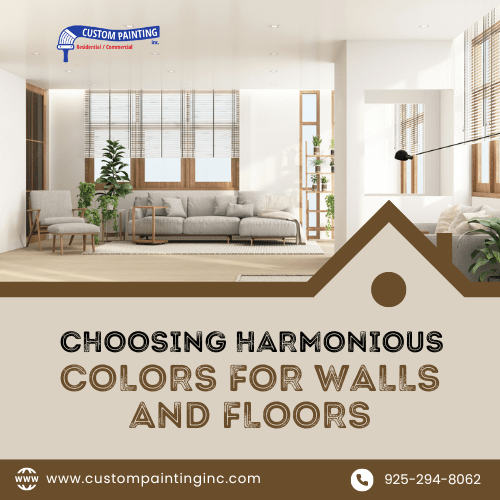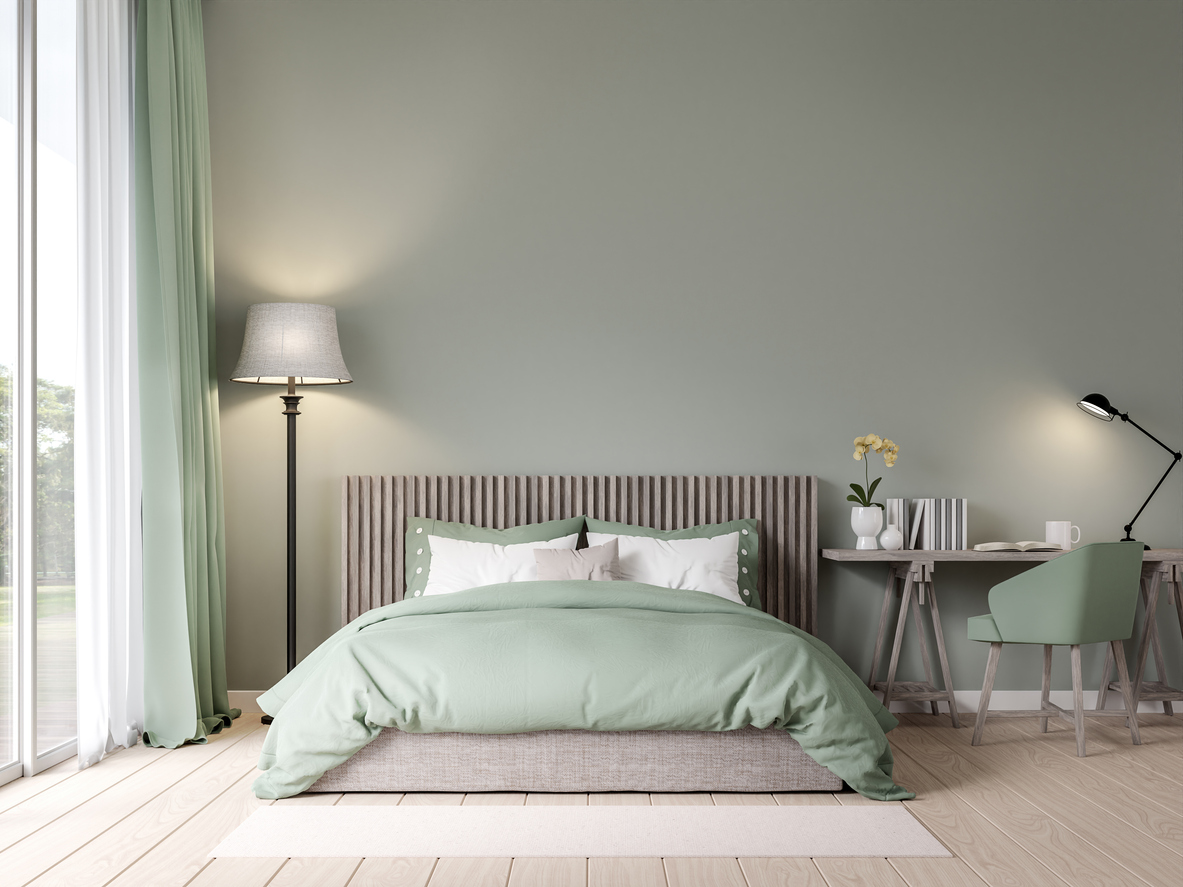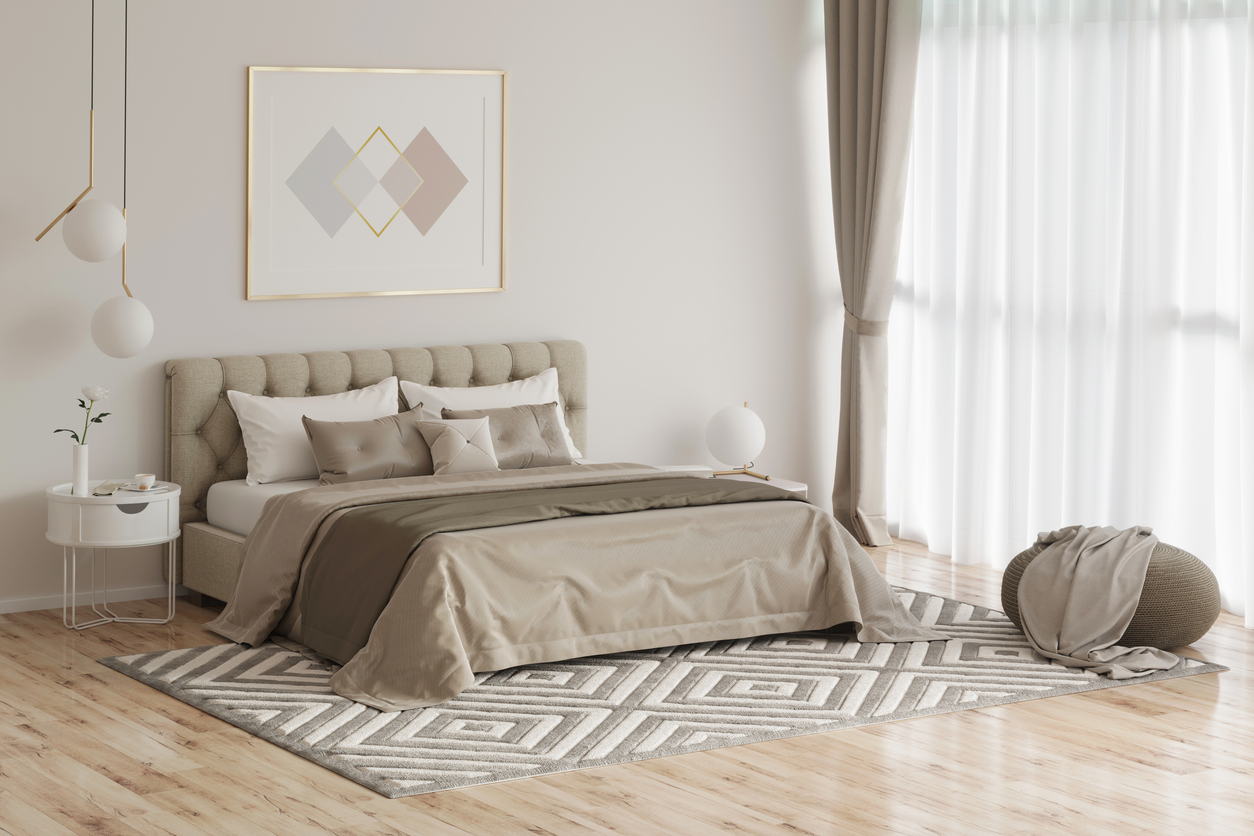When you decide to design a new home or to give a new look to your existing space, matching the colors of the walls and floors is always a tricky challenge. The overall look and feel of any room depend on these. So, how do we create the perfect pairing? Let’s explore how to choose harmonious colors for walls and floors.
Why is Color Harmony Crucial in Interior Design?
Color harmony is crucial in interior design. It’s about selecting colors that work well together, creating a balanced and pleasing look. When colors harmonize, they enhance the room’s beauty and evoke specific moods, making your space feel just right.
The colors you choose can dramatically change the perception of a room. Light colors can make a small space feel larger and more open, while dark colors can add warmth and intimacy. The right color combination can brighten a room, highlight architectural features, and even influence your mood.
Factors to Consider When Choosing Colors
Choosing the right combination of wall and floor colors is key to setting the style and mood of every room in your home. While personal taste plays a significant role, a few basic rules should be considered to achieve the perfect match. Here are the main factors to consider:
1. Room Dimensions
The size of the room is a fundamental aspect to consider. For smaller rooms, light tones for both the floor and walls can make the space feel larger and more open. On the other hand, large rooms with light-colored walls can sometimes appear stark or austere. In such cases, combining light walls with a dark floor, like a dark grey, can create a pleasing balance and make the environment more welcoming.
2. Lighting
Lighting greatly influences how colors are perceived. A poorly lit space, especially one lacking natural light, benefits from a lighter color palette to brighten up the room. Light flooring and walls, such as light grey floors paired with soft dove-colored walls, can make the space more open and inviting.
Conversely, rooms with plenty of natural light can handle darker colors, even if they are small. Natural light allows you to be more daring with your color choices, creating a stylish and unique look with darker tones.
3. Intended Use of the Room
The room’s function is another essential factor to consider. Different colors can evoke different moods and energies. For areas that are full of activity, like the living room and kitchen, bold contrasts and bright colors can add vitality and energy. These spaces benefit from dynamic color combinations that reflect their vibrant use.
In contrast, areas meant for rest and relaxation, such as the bedroom and bathroom, are best suited for soft contrasts and neutral colors. Tone-on-tone combinations in these spaces create a serene and calming atmosphere, ideal for unwinding.
While these guidelines are helpful, they are not set in stone. Feel free to experiment and break the rules if it suits your style. Beautiful contrasts with neutral tones can work wonderfully in classical bathroom spaces, for example. The key is to create a balance that feels right for you and enhances the overall aesthetic of your home.
Combining Light and Dark Colors
Apart from choosing specific colors, the main pairings of walls and floors can be divided into tone-on-tone combinations or contrasting combinations.
1. Tone-on-Tone Combinations
Tone-on-tone combinations create a certain continuity to the environment and for areas of the house that are meant to be cozy and relaxing. Its two subcategories include:
Light Tones
One popular approach is using light tones for walls and floors. This combination is perfect for creating a sense of space and brightness, making even the smallest and darkest rooms feel more open and airy. Light-colored walls and floors blend seamlessly to produce a serene and tranquil atmosphere. Imagine a living room with pale beige walls and light oak flooring—this setup can create a harmonious and relaxing environment.
Dark Tones
Another tone-on-tone option is using dark hues for both walls and floors. This combination works particularly well in large, bright rooms where deep colors can add warmth and coziness. Dark tones absorb light, which helps redefine the space and create a more intimate feel. Picture a spacious living room with deep blue walls and rich, dark, hardwood floors. This setup adds depth and elegance, making the space feel luxurious and inviting.
2. Contrasting Combinations
Unlike tone-on-tone pairing, a contrasting combination mixes it up. It’s better suited for the livelier areas of the house, and it’s great if you want to add a touch of character to the room.
Light Floors and Dark Walls
Contrasting light floors with dark walls can give a room character and highlight its features. This combination is excellent for rooms with simple, neutral furniture, as the contrast can make the space more dynamic.
For instance, a bathroom with light grey tile flooring and deep charcoal walls can emphasize elements like a stylish walk-in shower or unique vanity. The dark walls create a striking backdrop that makes the lighter floor stand out, adding a touch of drama and sophistication.
Dark Floors and Light Walls
Conversely, dark floors paired with light walls can create a stunning visual impact. This setup allows the floor to become a focal point, giving the room depth and grounding the space. This combination is common in modern design, where dark hardwood or tile floors are complemented by light grey or white walls.
For example, dark walnut flooring in a kitchen can contrast beautifully with crisp white walls, creating a clean, modern look. This pairing also works well in dynamic architectural spaces, such as a hallway or entryway, adding a touch of refinement and elegance.
Tips for Choosing Wall Colors
When selecting wall colors, consider how they will interact with your flooring. The right combination can enhance the overall ambiance and style of your room.
1. Neutral Tones
Neutral shades like white, beige, gray, and taupe are versatile and timeless, making them a popular choice for many homes. Here’s how they can work with different flooring options:
White and Off-Whites
- With light floors: Pairing white or off-white walls with light-colored floors like pale oak or light grey tile can create an airy, open feel, perfect for small spaces or rooms with limited natural light. This combination enhances the brightness and makes the room feel larger.
- With dark floors: Combining white walls with dark floors, such as dark hardwood or slate tiles, creates a striking contrast that adds elegance and depth to the room. The dark floors ground the space, while the white walls keep it feeling spacious and clean.
Gray
- With light floors: Gray walls paired with light floors can add a touch of sophistication to your space. Light wood or tile floors with gray walls work well in both modern and traditional settings, offering a neutral backdrop that allows other design elements to stand out.
- With dark floors: Dark floors with gray walls create a sleek and contemporary look. This combination is particularly effective in larger rooms, where the deep tones can create a cozy yet stylish environment. Adding accents of metal or glass can enhance this modern aesthetic.
Beige and Taupe
- With light floors: Beige or taupe walls with light floors, such as light oak or beige carpeting, create a warm and inviting atmosphere. This combination is ideal for living rooms and bedrooms, where comfort and coziness are key.
- With dark floors: Dark floors paired with beige or taupe walls provide a balanced contrast that feels both elegant and welcoming. The dark floors add richness, while the warm tones of the walls create a soothing and comfortable space.
2. Bold and Accent Colors
Bold colors like deep blues, rich greens, and vibrant yellows can make a strong impact when used thoughtfully. Here’s how they can be integrated with different flooring options:
Deep Blues
- With light floors: Deep blue walls with light floors, such as whitewashed wood or light grey tiles, can create a refreshing and dramatic look. This combination is ideal for creating a coastal or nautical theme, bringing a sense of calm and depth to the space.
- With dark floors: Pairing deep blue walls with dark floors, like dark oak or navy carpeting, can add a luxurious and intimate feel to a room. This combination works well in dining rooms or studies, where a rich and cozy ambiance is desired.
Rich Greens
- With light floors: Rich green walls with light floors can bring a touch of nature indoors. Light wood or cream-colored tiles with green walls create a fresh and vibrant space, perfect for kitchens or living areas.
- With dark floors: Dark floors paired with rich green walls can create a sophisticated and serene environment. This combination is great for bedrooms or libraries, where a restful and grounding atmosphere is beneficial.
Vibrant Yellows
- With light floors: Vibrant yellow walls with light floors can make a room feel cheerful and energetic. Light wood or pale tile floors with yellow walls are perfect for playrooms, kitchens, or any space where you want to promote a positive and lively vibe.
- With dark floors: Dark floors with vibrant yellow walls can create a bold and striking look. This combination is ideal for feature areas or accent walls, drawing attention and adding a burst of color without overwhelming the space.
Tips for Creating a Cohesive Look
While you have tons of choices out there, remember these tips to keep your choices looking cohesive:
Test colors.
Always test paint samples on your walls before making a final decision. Paint swatches directly on the wall to see how they interact with light and surrounding elements. View your samples in natural light, artificial light, and at various times of the day to get a true sense of how the color will look.
Balance light and dark shades.
Mixing light and dark shades adds depth and dimension to a room. Ensure a balance to prevent the space from feeling too heavy or too bland. Use dark colors sparingly to create focal points, while light colors can help balance and open up the space.
Use color to define spaces.
Different colors can delineate areas in open floor plans. Use color to define functional spaces like dining, living, and work. Paint architectural features like moldings, trim, and built-ins in contrasting colors to highlight these elements and add character to the room.
Incorporate patterns and textures.
Textured finishes add depth and interest to walls and floors. Consider options like textured paint, wallpaper, or textured flooring materials. Use patterns in rugs, upholstery, or accent pieces to complement solid wall and floor colors, ensuring they harmonize harmoniously.
Match undertones.
Undertones are the subtle hues beneath the main color. Matching undertones across walls, floors, and decor ensures color harmony. Be mindful of undertones to prevent colors from clashing. Test colors together to see how they interact in your space.
Do not use too many colors.
Stick to a limited color palette to maintain a cohesive look. Too many colors can make a space feel chaotic and disjointed. Use accent colors sparingly to add interest without overwhelming the space. Accents can be introduced through accessories, artwork, and small decor items.
Conclusion
The colors you pick for your walls and floors can make or break the look of your interior design. Surely, you want it to look beautiful and inviting, so take note of the tips we shared with you. But do not be afraid to experiment and find the perfect color combination that reflects your style and personality.
For expert advice and assistance, call Custom Painting, Inc. at 925-686-0903 or complete our online form. Let us help you create the home of your dreams.




